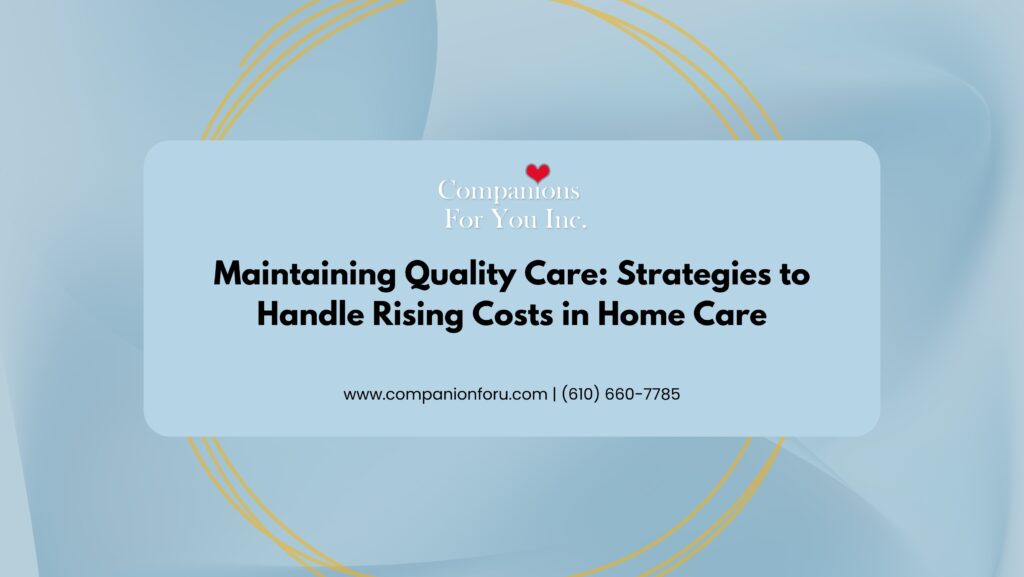As the demand for home care services continues to rise, so do the associated costs. Home care agencies face the challenge of maintaining high-quality care while managing increasing expenses. In this blog, we will explore strategies to handle rising costs in home care without compromising the quality of services provided.
Understanding the Cost Challenges in Home Care
Several factors contribute to the rising costs of home care services:
- Labor Costs: The home care industry is labor-intensive, and wages for caregivers are increasing. This is driven by the need to attract and retain qualified caregivers amidst a growing demand for services.
- Regulatory Compliance: Compliance with state and federal regulations, such as Electronic Visit Verification (EVV) and data privacy laws, requires significant investment in technology and administrative resources.
- Technology Investments: While technology can improve the efficiency and quality of care, the initial investment in advanced systems and devices can be substantial.
- Healthcare Inflation: General inflation in healthcare costs, including medical supplies and equipment, also impacts home care expenses.
Strategies for Handling Rising Costs
Despite these challenges, there are several strategies that home care agencies can adopt to manage rising costs while maintaining quality care:
- Optimize Operational Efficiency: Streamlining administrative processes and reducing inefficiencies can help control costs. Implementing automated scheduling, billing, and documentation systems can save time and reduce errors.
- Invest in Caregiver Training: Investing in ongoing training and professional development for caregivers can improve their skills and efficiency, leading to better care outcomes and reduced turnover.
- Leverage Technology: Using technology such as remote patient monitoring and telehealth services can reduce the need for in-person visits and improve health management. This can lead to cost savings in the long run.
- Flexible Staffing Models: Implementing flexible staffing models, such as part-time or on-call caregivers, can help manage labor costs while ensuring that client needs are met.
- Partner with Healthcare Providers: Collaborating with hospitals, clinics, and other healthcare providers can enhance care coordination and reduce duplication of services, leading to cost savings.
- Focus on Preventive Care: Emphasizing preventive care and health education can help reduce the incidence of chronic conditions and hospitalizations, ultimately lowering healthcare costs.
Maintaining Quality While Managing Costs
Maintaining quality care is paramount, even when managing rising costs. Here are some key considerations:
- Client-Centered Care Plans: Develop personalized care plans that focus on the specific needs and preferences of each client. This ensures that resources are used effectively and that clients receive the most appropriate care.
- Regular Quality Assessments: Conduct regular assessments of care quality and client satisfaction. Use this feedback to identify areas for improvement and make necessary adjustments.
- Caregiver Support: Provide support and resources for caregivers to help them deliver high-quality care. This includes access to training, mental health resources, and opportunities for career advancement.
Companions For You Inc.: Committed to Quality and Efficiency
At Companions For You Inc., we understand the importance of balancing cost management with the delivery of high-quality care. Our commitment to operational efficiency, caregiver training, and innovative technology ensures that we provide exceptional care while managing expenses effectively. Visit our In-Home Care page to learn more about our cost-effective care solutions.
Challenges and Solutions
While managing rising costs is challenging, adopting the right strategies can make a significant difference:
- Resource Allocation: Carefully allocate resources to areas that have the greatest impact on care quality and efficiency. Prioritize investments that offer long-term benefits and cost savings.
- Continuous Improvement: Embrace a culture of continuous improvement. Regularly review and refine processes to enhance efficiency and quality.
- Stakeholder Engagement: Engage with clients, caregivers, and other stakeholders to gather insights and feedback. This collaborative approach helps ensure that care remains client-centered and effective.
Conclusion
Handling rising costs in home care requires a strategic approach that balances efficiency with quality. By optimizing operations, investing in technology and training, and focusing on client-centered care, home care agencies can manage expenses while providing high-quality services. At Companions For You Inc., we are dedicated to maintaining excellence in care, ensuring that our clients receive the best possible support.For more information on our cost-effective care strategies, visit our Google Business Profile.

